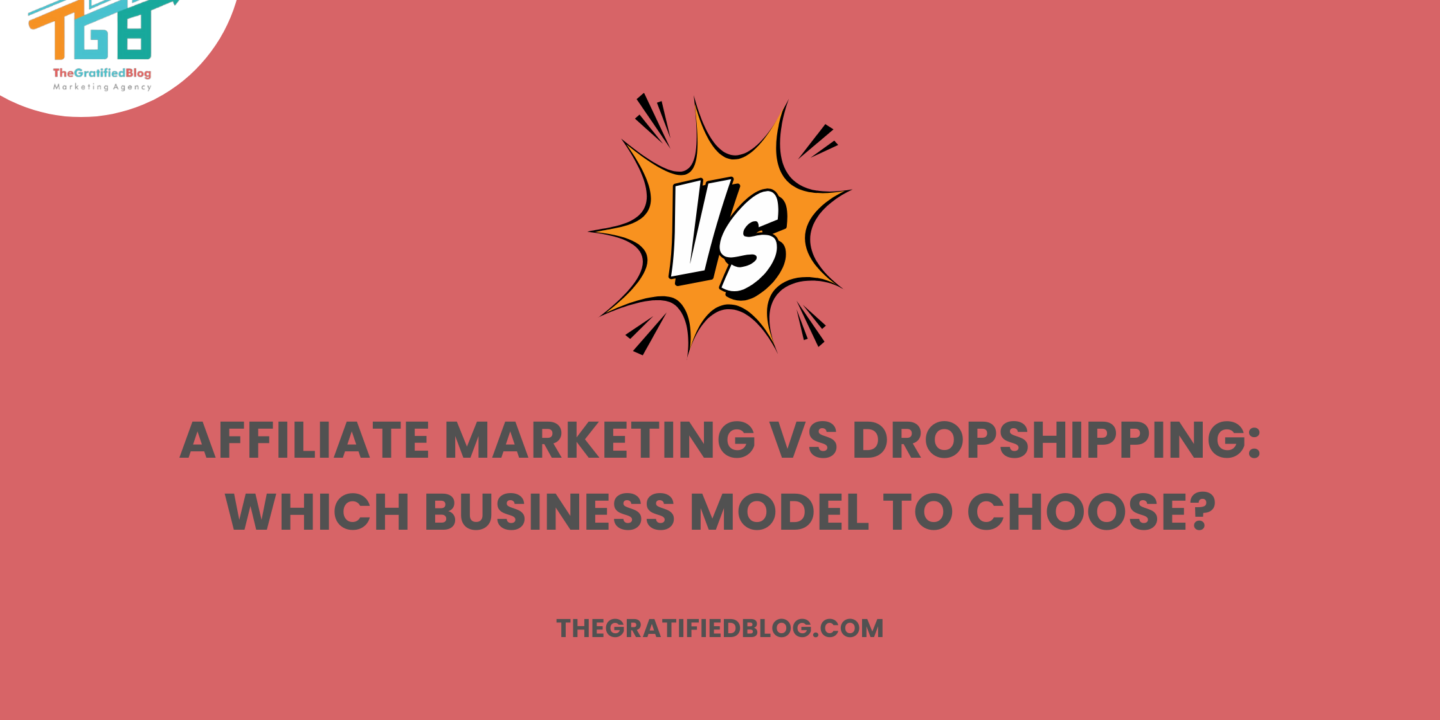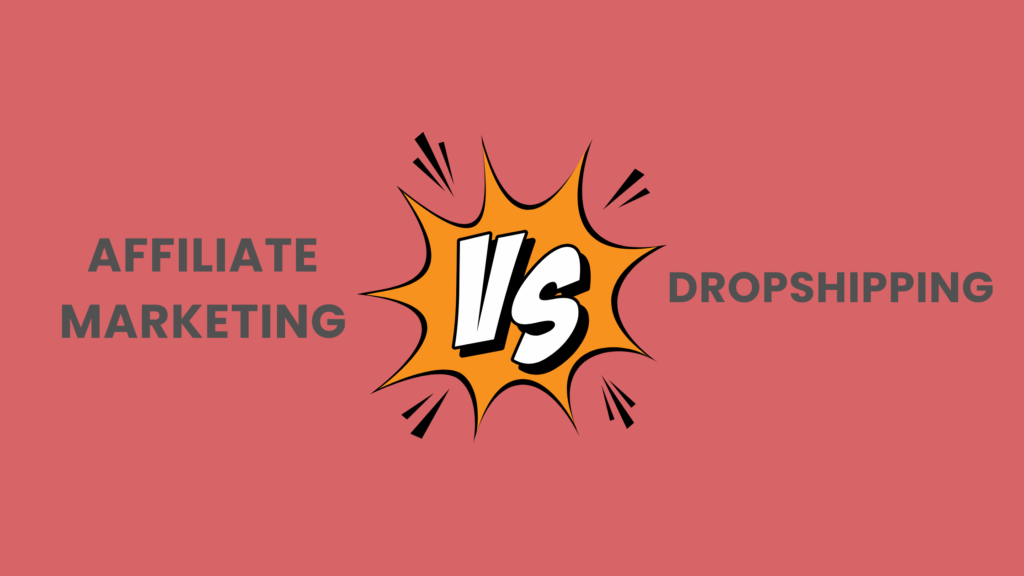
In e-commerce and online entrepreneurship, two popular business models have emerged as contenders for aspiring digital entrepreneurs: affiliate marketing and dropshipping. Both offer promising opportunities to generate income and build successful online ventures, yet they operate on fundamentally different principles. In this blog, we delve into the intricacies of affiliate marketing vs dropshipping, exploring their pros and cons, revenue potentials, and suitability for various entrepreneurial goals.
Whether you’re a newcomer to the online business scene or a seasoned entrepreneur looking to diversify your revenue streams, understanding the distinctions between these two models is crucial for making informed decisions and charting a path towards sustainable success.
Let’s begin this journey of exploration and unravel the intricacies of the topic mysteries of affiliate marketing and dropshipping to determine which one reigns supreme in online commerce.
What Is Affiliate Marketing?

Affiliate marketing operates as a marketing strategy based on performance, where businesses reward affiliates for directing traffic or generating sales for their products or services via the affiliate’s marketing efforts. In short, affiliates earn commissions for promoting other people’s or companies’ products.
How Affiliate Marketing Works?
- Partnership Formation: Affiliates join affiliate programs offered by companies or individuals, agreeing to promote their products or services in exchange for a commission. This partnership establishes a mutually beneficial relationship where affiliates leverage their marketing skills and audience reach to drive traffic and sales for the merchant. In contrast, the merchant compensates affiliates for their promotional efforts based on predefined commission structures.
- Promotion and Revenue Generation: Affiliates use various marketing channels such as websites, blogs, social media, email marketing, and online advertising to promote the products or services to their audience. They create compelling content, product reviews, and recommendations. The affiliate garners a commission when visitors engage with the promotional campaigns, click on the affiliate’s unique tracking links, and purchase or complete a desired action (such as signing up for a newsletter or filling out a form). This commission is tracked and recorded by the affiliate program, which calculates the commissions owed to the affiliate based on the agreed-upon terms and pays out commissions regularly through bank transfers, PayPal, or checks.
What Is Dropshipping?

Dropshipping is a retail fulfilment where stores refrain from stocking the products they sell. Instead, upon receiving an order, the store purchases the item from a third party and arranges for it to be shipped directly to the customer. Consequently, the seller needs to be more involved in physically handling or seeing the product.
How Dropshipping Works?
Product Selection And Store Setup
In dropshipping, entrepreneurs first select products from suppliers or wholesalers offering dropshipping services. These products are featured in an online store using e-commerce platforms like Shopify or WooCommerce. The entrepreneurs customise their store, including design elements and product listings, to appeal to their target market.
Customer Orders And Supplier Fulfillment
When a customer places an order on the dropshipping store and pays, the entrepreneur receives the order details, including the customer’s shipping address and the purchased product. Instead of keeping an inventory, the entrepreneur forwards the order and customer details to the dropshipping supplier.
The supplier then fulfils the order on behalf of the entrepreneur by packaging the product and shipping it directly to the customer. This eliminates the need for the entrepreneur to handle inventory or manage shipping logistics.
Order Management And Customer Service
While the dropshipping supplier handles order fulfilment, the entrepreneur manages the customer experience. This includes providing customer support, handling, Responding to inquiries and resolving any issues that may arise with orders or products.
The entrepreneur acts as the primary point of contact for customers, maintaining communication throughout the order process and ensuring a positive buying experience. Through proficiently handling customer relationships and delivering outstanding service, entrepreneurs can build trust and loyalty, driving repeat business and long-term success in the dropshipping model.
Now that you have a fundamental understanding of affiliate marketing and dropshipping, let’s talk about the actual topic of the blog, i.e., affiliate marketing vs dropshipping.
Comparing Affiliate Marketing Vs Dropshipping

Startup Costs And Investment
Affiliate Marketing:
- Low Barrier to Entry: Affiliate marketing typically requires minimal startup costs as affiliates don’t need to create or invest in products, manage inventory, or handle shipping logistics.
- Investment in Marketing Channels: Affiliates may need to invest in website hosting, domain registration, content creation, and marketing tools to promote affiliate products effectively.
- Optional Expenses: While affiliate marketing can be started with very little upfront investment, affiliates may invest in paid advertising, email marketing software, or other promotional channels to scale their efforts.
Dropshipping:
- Moderate Startup Costs: Dropshipping businesses incur moderate startup costs, including setting up an online store, purchasing a domain, and possibly investing in e-commerce platforms or plugins.
- Product Costs: Dropshippers must pay for the products they sell to customers, although they don’t need to purchase inventory upfront. Instead, they pay for products as customers order them.
- Marketing and Advertising Expenses: Unlike affiliate marketing, dropshippers may need to invest in marketing and advertising to attract customers to their online store and drive sales.
- Additional Costs: Dropshippers may also incur expenses related to website development, customer service tools, and payment processing fees.
Time And Effort Required
Affiliate Marketing:
- Content Creation: Affiliates must invest time and effort in creating high-quality content like blog posts, reviews, videos, or social media posts to attract audiences and engage their audience.
- Promotion and Marketing: Successful affiliate marketers dedicate time to promoting affiliate products through various marketing channels, including search engine optimisation (SEO), social media marketing, email marketing, and paid advertising.
- Relationship Building: Building trust with their audience and establishing credibility in their niche requires consistent effort and engagement.
Dropshipping:
- Store Setup and Product Selection: Setting up a dropshipping store involves choosing products to sell, designing the website, and optimising product listings for conversion.
- Supplier Management: Dropshippers must find reliable suppliers, negotiate terms, and maintain good relationships to ensure smooth order fulfilment and customer satisfaction.
- Marketing and Customer Acquisition: Dropshipping businesses must invest time and effort in marketing their store and products to attract customers, drive traffic, and generate sales.
- Order Management and Customer Service: Managing orders, handling customer inquiries, and resolving issues require ongoing attention and responsiveness.
Revenue Potential

Affiliate Marketing:
- Commission-Based Earnings: Affiliates earn commissions on referred sales or actions, typically ranging from a few per cent to a higher percentage of the sale price.
- Passive Income Potential: Once affiliate content is created and published, it can continue to generate passive income through organic search traffic and ongoing promotion.
- Scalability: Affiliate marketing income can scale with the growth of the affiliate’s audience and the effectiveness of its marketing efforts.
Dropshipping:
- Profit Margins: Dropshippers can set their own prices and markup products to earn a profit on each sale. However, profit margins may be lower than selling directly sourced or manufactured products.
- Sales Volume: Dropshipping businesses can achieve high sales volumes by offering a wide range of products and reaching a large audience through effective marketing and promotion.
- Revenue Growth: Successful dropshipping businesses can scale their revenue by expanding product offerings, optimising marketing strategies, and increasing customer acquisition efforts.
Control And Flexibility
Affiliate Marketing:
- Limited Control Over Products: Affiliates have no control over the products or services they promote, as the merchant or affiliate program provides them.
- Flexibility in Promotional Strategies: Affiliates can choose how to promote affiliate products, including the content format, marketing channels, and tactics.
- Independence: Affiliates operate independently of product creation, inventory management, and order fulfilment, allowing them to focus on marketing and promotion.
Dropshipping:
- Product Selection and Pricing: Dropshippers can control their products and adjust prices, product descriptions, and branding to suit their target market and competitive landscape.
- Order Fulfillment: While drop shippers rely on suppliers to fulfil orders, they have some control over the customer experience, including packaging, shipping times, and returns policies.
- Adaptability: Dropshipping businesses can quickly adapt to market trends, customer preferences, and product demand by adding or removing products from their inventory and adjusting pricing and promotions.
Risk Management

Affiliate Marketing:
- Low Financial Risk: Affiliates face minimal financial risk since they don’t need to invest in inventory, product development, or order fulfilment.
- Dependency on Affiliate Programs: Affiliates rely on affiliate programs and merchant partners for commission payments and program terms, which could change or be terminated unexpectedly.
- Market and Competition Risk: Affiliates may Encounter competition from other affiliates promoting comparable products or services, affecting their ability to generate commissions.
Dropshipping:
- Inventory Risk Mitigation: Dropshippers mitigate the risk of unsold inventory and excess stock by only purchasing products as customers order them.
- Supplier Reliability: Dropshippers depend on suppliers for product availability, quality, and timely order fulfilment. Working with reliable suppliers reduces the risk of fulfilment issues.
- Market and Competitive Risks: Dropshipping businesses may face competition from other online retailers and marketplaces, as well as challenges related to pricing, shipping times, and customer service.
Sustainability And Longevity
Affiliate Marketing:
- Passive Income Potential: Successful affiliate marketers can build passive income streams by creating evergreen content that remains compelling, drawing and converting customers consistently.
- Diversification: Affiliates can diversify their income by promoting products in multiple niches or joining various affiliate programs to reduce dependence on any single source of revenue.
- Long-Term Growth: Affiliate marketing can offer long-term growth opportunities as affiliates build their audience, establish authority in their niche, and expand their reach through ongoing content creation and promotion.
Dropshipping:
- Competitive Landscape: Dropshipping operates in a highly competitive market, with low barriers to entry, attracting many new entrants and increasing competition for customers and market share.
- Brand Building: Successful dropshipping businesses focus on building a solid brand identity, customer loyalty, and repeat business to sustain long-term growth and profitability.
- Adaptability and Innovation: Dropshippers must stay ahead, stay abreast of market trends, adjust to evolving consumer preferences, and innovate in product selection, marketing strategies, and customer experience to remain competitive and sustainable.
Personal Preferences And Skills
Affiliate Marketing:
- Strengths: Affiliate marketing may be suitable for individuals with solid writing, content creation, and marketing skills, as well as those who prefer a passive income model with minimal operational responsibilities.
- Challenges: Affiliates must be adept at content creation, search engine optimisation (SEO), and audience engagement to attract and convert visitors into customers. They must also be comfortable with variable income and rely on third-party programs for commission payments.
Dropshipping:
- Strengths: Dropshipping may appeal to individuals with a knack for product selection, branding, and customer acquisition, as well as those who enjoy the challenge of building and scaling an e-commerce business.
- Challenges: Dropshippers must be skilled in website development, product sourcing, marketing, customer service, and order management to succeed. They also face operational challenges such as inventory management, supplier relationships, and fulfilment logistics.
In conclusion, affiliate marketing and dropshipping offer unique opportunities for aspiring entrepreneurs to build successful online businesses. The choice between the two depends on factors such as startup costs, time and effort required, revenue potential, and control.
Now, let’s delve into the essential factors to consider when deciding between Affiliate Marketing and Dropshipping.
Critical Considerations For Choosing Between Affiliate Marketing And Dropshipping
Goals and Objectives:
- Evaluate your long-term goals and objectives for your online business, such as generating passive income, building a brand, or achieving scalable growth.
- Determine whether affiliate marketing or dropshipping aligns better with your goals and offers the potential to fulfil your objectives effectively.
Financial Resources:
- Assess your financial resources and budget available for starting and operating an online business.
- Consider the startup costs, ongoing expenses, and potential revenue streams associated with affiliate marketing and dropshipping.
- Choose the business model that fits your financial capabilities and offers a favourable return on investment.
Time Commitment:
- Assess the time you can allocate to regularly managing and growing your online business.
- Consider the time required for content creation, marketing, order fulfilment, customer service, and business management.
- Choose the business model that aligns with your available time commitment and allows you to balance other personal or professional obligations effectively.
Market Analysis and Niche Selection:
- Perform comprehensive market research to discover lucrative niches, target audiences, and competitive landscape for affiliate marketing and dropshipping.
- Analyse market trends, consumer demand, competition level, and revenue potential in your chosen niche.
- Select the business model that offers opportunities for differentiation, market positioning, and competitive advantage within your target niche.
Skillset and Experience:
- Assess your skills, knowledge, and experience in marketing, sales, e-commerce, content creation, and customer service.
- Identify areas where you have strengths and expertise that can be leveraged to succeed in affiliate marketing or dropshipping.
- Consider whether you have the necessary skills or Readiness to acquire and hone new skills for each business model.
Risk Appetite:
- Evaluate your tolerance for risk and willingness to take on challenges associated with starting and operating an online business.
- Consider the inherent risks and uncertainties involved in affiliate marketing and dropshipping, such as market competition, supplier reliability, and revenue fluctuations.
- Choose the business model that aligns with your risk appetite and balances potential rewards and challenges based on your comfort level.
FAQs
Q1. What sets affiliate marketing apart from dropshipping?
A. Affiliate marketing involves promoting products or services others offer and earning commissions for successful referrals. On the other hand, dropshipping entails selling products through an online store without keeping inventory, as suppliers fulfil orders directly. While affiliate marketers focus on marketing and promotion, dropshippers manage product sourcing, customer service, and order fulfillment.
Q2. Which business model requires less initial investment, affiliate marketing or dropshipping?
A. Affiliate marketing typically requires a lower initial investment compared to drop shipping. Affiliates can promote products immediately without purchasing inventory or setting up an online store. Conversely, dropshipping involves setting up an e-commerce store, selecting products, and investing in website development and marketing. While both models have minimal startup costs compared to traditional retail, affiliate marketing offers a lower barrier to entry for beginners.
Conclusion
Now that you’ve gained insight into the distinctions between affiliate marketing and dropshipping, it’s evident that each model offers unique advantages and challenges.
Choosing between the two depends on your goals, resources, skills, and risk tolerance. By carefully considering these aspects, you can make a well-informed choice and select the business model that aligns best with your objectives and circumstances.
If you still have any questions related to the blog, please leave them in the comments section. We will be happy to answer you.
Thanks for reading 🙂








No Comments